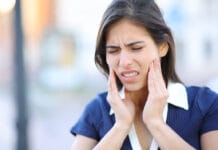The majority of our education in dentistry rightfully consists of increasing our patients’ quality of life by addressing current dental issues and preventing future problems. We provide an essential service to our communities full of people who desperately need our help and guidance.
At the same time, who is looking out for us?
Our jobs can be very physical, which may be surprising to those outside our sphere. The job can be psychologically stressful and physically exhaustive. Our movements can be repetitive and our instincts sharp, especially with a wiggly toddler in the chair.
Musculoskeletal Disorders among Italian Dentists and Dental Hygienists is a study that identifies the physical ailments that dental professionals may suffer from at times during their clinical career due to the nature of our jobs. Much like we do for our patients, we can learn to identify early warning signs, such as pain, and shift our behavior to prevention mode before our problems hurt the way we do our jobs and take care of our families.
Reported Musculoskeletal Problems in Dentistry
Dental professionals were questioned about their health in relation to their jobs. Barring any diseases that would cause problems in the musculoskeletal system, complaints of pain and inflammation were taken seriously and documented as being related to the nature of your work.
Bending over the chair with a hunched back, moving your wrists in a repetitive motion while scaling, bending your arms in almost impossible directions to reach the distals of those back molars, and all the other twisting and turning you do to complete your tasks all burn calories, increase your flexibility, and damage muscle and tissue when done repetitively.
The professionals were questioned about the pain they feel, especially pain that gets worse throughout the workday in relation to:
- wrist/hand (30.6%)
- neck (59.9%)
- shoulders (43.3%)
- upper back (37.7%)
- lower back (52.1%)
- elbows (11.9%)
- hips (16.9%)
- knees (19%)
- ankles (14.7%)
While all of these areas are natural places for the pain to develop with age, the way you move and hold yourself can and will exacerbate any existing issues or even start issues that you may never have developed otherwise.
The Facts
During the course of their research, a few facts were discovered that can help you address and prevent the musculoskeletal problems that come from working in a dental office every day. Of course, the longer you work in your position, the higher chance you have at developing an issue in one of the problem areas. That’s true anywhere you go and whatever you do.
The research revealed:
- 84.9% of respondents reported work-related musculoskeletal disorders (WRMD) within the past 12 months.
- Of that 84.9%, 83.1% were diagnosed by a physician with a WRMD.
- 1% reported that a WRMD interfered with their daily life in the last year.
- 9% reported a WRMD within the past seven days.
The research showed that WRMDs increased with age; those under 35 years old showed a lower percentage of WRMDs compared to older dental professionals whose WRMD peaked between 36-50 years old (94.2%).
Longer working hours per day (over 8 hours) and working more hours or days per week (over 40 hours) showed an increase in WRMDs in 90% of the cases.
Surprisingly, a person’s weight had no effect on the reports of pain, but height, in fact, did. Taller people overwhelmingly reported more pain than shorter folks, while females reported more pain than males in all aspects, though males overwhelmingly reported troubles with their knees.
Dental specialists reported the highest amount of daily, weekly, and yearly pain (90.8%) than did dental hygienists (80.7%) and dentists (84.9%) alike.
The largest discovery came when the researchers broke up the body into its parts and evaluated the most problematic areas for people in our line of work. The statistics suggest that elbows, knees, ankles, and hips will fair better than the rest of your body unless your weekends consist of tackle football.
Wrists, upper back, and shoulders are much more affected in the dentistry field, and any pain that you have should be monitored and checked out. The majority of dental professionals complained of pain in their neck.
It was found that dental professionals who engaged in physical activity, including yoga and stretching, reported a lower prevalence of WRMDs – 77.2% compared to 84.3%.
So, as you all go about your jobs this week, pay attention to your ergonomics and the way you are holding your neck, twisting your back, and manipulating your instruments. We should practice what we preach and take preventative measures in our own lives, with our own health. Small changes equal big results. If you don’t take care of yourself, it’s hard to take care of others.
Before you leave, check out the Today’s RDH self-study CE courses. All courses are peer-reviewed and non-sponsored to focus solely on high-quality education. Click here now.











